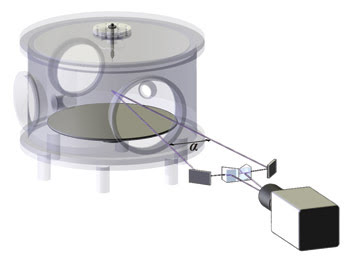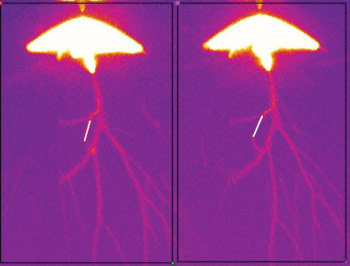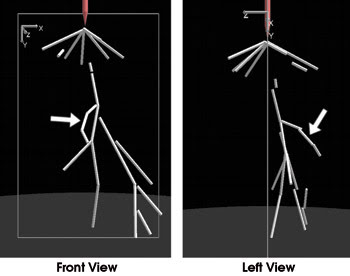Images of streamers usually have been limited to two dimensions, an arrangement that easily leads to mistakes about their true form. A technique has been devised to capture this naturally occurring phenomenon in three dimensions.
Michael A. Greenwood, News Editor
A clap of thunder usually is followed by a discharge of light that breaks into multiple branches as it crackles high in the sky. This natural occurrence is understood well enough, but attempts at capturing an image of these streamer discharges usually result in a two-dimensional representation of what is a three-dimensional phenomenon. Without the extra dimension, it is difficult, if not impossible, to accurately study a streamer’s form and structure. What appears to be a loop in a 2-D image, for instance, may in fact be a stray branch that never reconnects. A third dimension can detect this and also enables the angles at which the multiple branches of streamers occur to be accurately measured.
Besides the occurrence of streamers in nature, where they appear as sprites and precede lightning, similar phenomena also occur with sparks. To overcome the problem of the missing dimension and to better understand the physics involved, investigators at Eindhoven University of Technology in the Netherlands used a stereophotographic method that allowed them to reconstruct and evaluate streamer discharges in 3-D.
Generating a discharge
To generate the streamers, they used a capacitor that was negatively charged with a DC power supply. A spark-gap switch was used to discharge the capacitor, resulting in a positive voltage peak on a needle positioned inside the airtight vessel. This in turn produced a positive corona discharge from the needle to the grounded plate situated below (Figure 1). A positive voltage of 47 kV with a rise time of about 30 ns was applied to the needle 14 cm above the bottom plate. The atmospheric air pressure within the vacuum chamber, meanwhile, varied between 200, 565 and 1000 mbar. Details of the research were published in the March 10, 2008, issue of Applied Physics Letters.

Figure 1. This schematic overview of the stereoscopic measurement setup shows the vacuum vessel with the anode pin and the cathode plate, the intensified CCD camera, two prisms and the two optical paths. Images reprinted with permission of Applied Physics Letters.
Although other researchers have reconstructed 3-D images of sparks using a camera and a prism to form an image at a right angle to the one directly observed, the technique is limited in that it only works with discharges that have very few channels. In the latest research, the team wanted to study discharges containing up to 100 streamers.
The investigators used a method similar to the one described above, but with an important difference. In this case, they relied on a much smaller angle between the two image paths that were formed. The smaller angle was achieved by using a Stanford Computer Optics intensified CCD camera with a 1.8-ns minimum gate time and a 105-mm quartz lens in combination with two prisms and two flat mirrors. This setup allowed two images from different viewing angles to be captured on one camera frame. As a result, the images were temporally synchronized.

Figure 2. In this stereo image recorded by the camera, one streamer section has been highlighted with a white line in both images to form the 3-D image.
True shape and form
From this 2-D image, they reconstructed a 3-D image by selecting a straight section of streamer channel (Figure 2) in each of the two images captured. These two images provided the 2-D coordinates. The third dimension, the depth coordinate Z, was approximated using mathematical formulas. The technique can be applied to all streamer sections in an image, allowing for a more accurate picture to emerge of a streamer discharge’s true shape and form (Figure 3). The error in streamer location as a result of the calculation process was determined to be less than 0.2 mm. The investigators also found that the technique was limited by the number of streamer channels that could be handled. Streamers with more than 50 channels could not be processed fully.

Figure 3. In this orthogonal view of the 3-D reconstruction of streamer structure, the section marked with a white line in Figure 2 is now marked with a white arrow.
Measurements of the branching angles for the three different ambient pressures showed that the angles averaged between 39° and 46°. The branching angle was slightly influenced by the pressure within the chamber. At 220 mbars of pressure, for instance, the average angle was 46.0 ±10.8°. When the pressure was increased to 1000 mbars, the average angle fell to 39.7 ±13.2°. The investigators said that this fluctuation may not be statistically significant, given that only 35 data points were used per pressure setting.
The branching angle as a function of pressure and the vertical distance from the tip at the point of branching also were determined to be statistically insignificant. Lastly, the ratio of streamer length between branches to streamer width was determined to be 15 for all of the pressures studied.
The researchers, together with investigators at Centrum voor Wiskunde en Informatica in Amsterdam, will use the results to advance theoretical models of streamer discharges. Development and improvement of applications of streamer discharges such as ozone generation and consecutive disinfection, biofuel processing, plasma-assisted combustion and aviation will require better knowledge of streamers.
Contact: Sander Nijdam, Eindhoven University of Technology; fax: +31 40 245 6050; e-mail: [email protected].